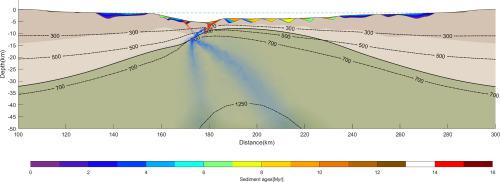Physics of the Earth and Planetary Interiors ( IF 2.4 ) Pub Date : 2021-05-26 , DOI: 10.1016/j.pepi.2021.106748 Iskander A. Muldashev , Marta Pérez-Gussinyé , Mário Neto Cavalcanti de Araújo

|
Physical processes interact during rifting to produce a range of crustal and sedimentary architectures and subsidence histories. Methodologies to analyze these processes combine techniques such as cross-section restoration, backstripping and numerical simulations. Despite the valuable outcomes of each method, intrinsic limitations related to particular interactions between kinematics and thermo-mechanics leave open questions on how seismic interpretation is consistent in terms of thermomechanical aspects of lithospheric extension. In this work, we present a new modelling technique, KineDyn, to simulate basement architecture, heat-flow, subsidence and sedimentation patterns along a given basin-scale seismic reflection profile in 2D. KineDyn is the fusion of dynamic thermomechanical approach and kinematic forward modelling of faulting and excludes drawbacks of conventional methods while preserving their valuable outcomes. In our approach, faults are initially controlled by prescribed initial locations, slips and timings, while the rest of the model is resolved in a fully dynamic mode, with non-linear visco-elasto-plastic rheology. KineDyn allows dynamic simulation of the response of the lower crust and mantle to different patterns of faulting in time and space and direct comparison to seismic observations. Thus, it gives, in effect, the same results as existing section restoration techniques (i.e. the potential history of faulting) and forward modelling techniques (i.e. the likely history of sedimentation, thinning, heat flow and subsidence), while simultaneously taking into account non-linear interactions between processes occurring during rifting. In addition, comparison of the model outcomes to lithospheric-scale seismic observations gives insight into the relationship between shallow crustal structures and deeper geodynamic processes in the lithosphere-asthenosphere system, which shape rifts.
中文翻译:

KineDyn:用于验证地震解释和裂谷和裂谷边缘动力学研究的热机械正向方法
裂谷期间物理过程相互作用,产生一系列地壳和沉积结构以及沉降历史。分析这些过程的方法结合了诸如横截面恢复、反剥和数值模拟等技术。尽管每种方法都取得了有价值的成果,但与运动学和热力学之间的特定相互作用相关的内在局限性仍然存在悬而未决的问题,即地震解释如何在岩石圈伸展的热力学方面保持一致。在这项工作中,我们提出了一种新的建模技术 KineDyn,以沿给定的 2D 盆地尺度地震反射剖面模拟基底结构、热流、沉降和沉积模式。KineDyn 是动态热机械方法和断层运动学正演建模的融合,排除了传统方法的缺点,同时保留了其有价值的结果。在我们的方法中,故障最初由规定的初始位置、滑动和时间控制,而模型的其余部分则以完全动态模式解决,具有非线性粘弹塑性流变学。KineDyn 允许动态模拟下地壳和地幔对不同时空断层模式的响应,并与地震观测直接比较。因此,它实际上给出了与现有剖面恢复技术(即断层的潜在历史)和正向建模技术(即沉积、变薄、热流和沉降的可能历史)相同的结果,同时考虑到裂谷期间发生的过程之间的非线性相互作用。此外,将模型结果与岩石圈尺度地震观测结果进行比较,可以深入了解形成裂谷的岩石圈-软流圈系统中浅层地壳结构与深层地球动力学过程之间的关系。











































 京公网安备 11010802027423号
京公网安备 11010802027423号